Believe it or not: When this introductory sentence of the first edition of the ARD/ZDF online study was formulated, Mark Zuckerberg was just thirteen years old and Netflix was founded to send DVDs by mail. This year now marks the 25th anniversary of the study, making it one of the oldest continuous population studies on Internet use ever. The 2021 results show that video and audio content dominate online media use. Among the social media platforms, Facebook (but not Meta) has lost its supremacy and the old Messenger top dog is also the new one.
14- to 29-year-olds as drivers of development
A quarter of a century in which a lot has happened in terms of online media use. While there were only 4.1 million Internet users in Germany in 1997, corresponding to 6.5 percent of the adult population, almost 67 million use the Internet in 2021. The following figures also show how much the Web has become established: A staggering 100 percent of those under 50 use online services, and 77 percent of those over 70 still do. The Internet has grown up.
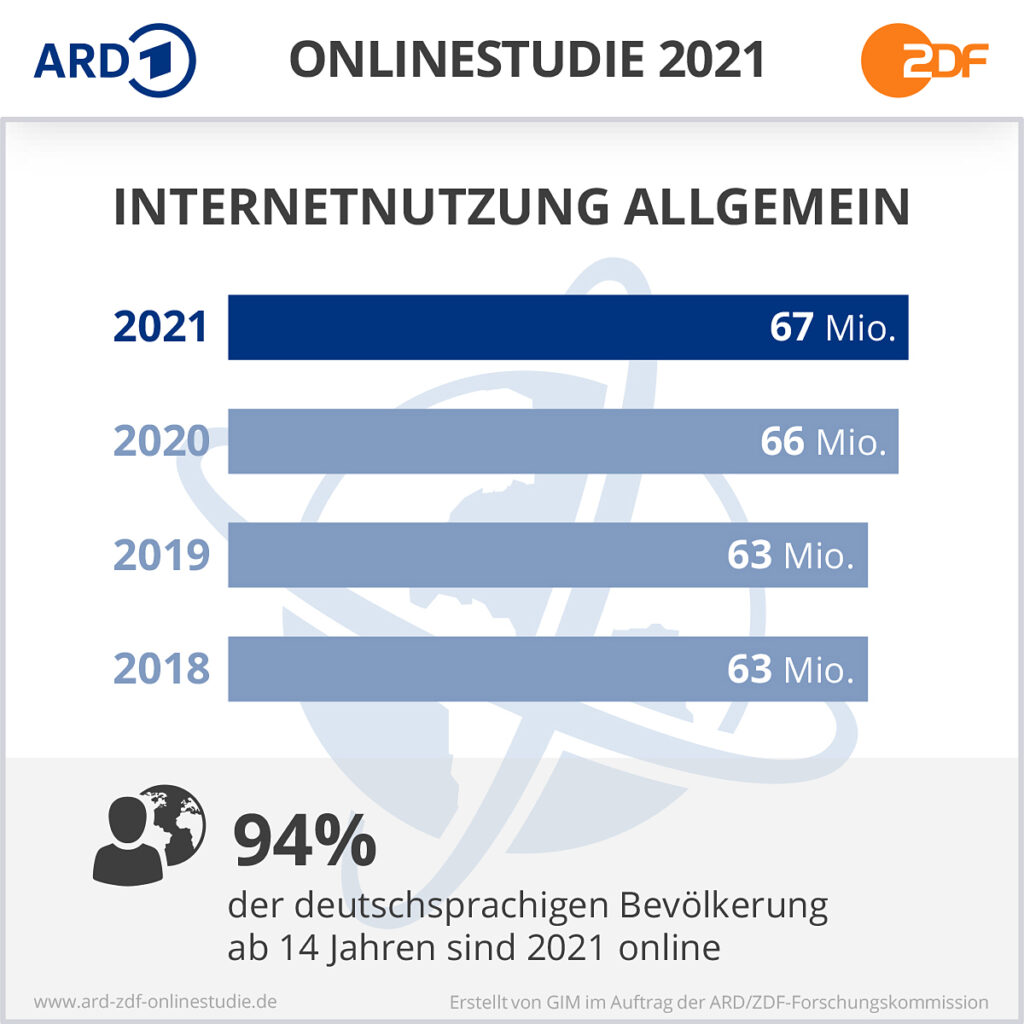
However, there are greater age differences with regard to the daily duration of Internet use. While this is 227 minutes across all respondents*, 14- to 29-year-olds spend 419 minutes – almost six and a half hours! – online.
Large portions of this are used to consume online media: a good two hours (136 minutes) in the basic population compared to four and a half hours (269 minutes) among 14- to 29-year-olds and three hours (178 minutes) among 30- to 49-year-olds.
Video (total: 64 minutes) and audio content (56 minutes) are in particular demand, while only an average of 20 minutes is spent on online text consumption. Here, too, 14- to 29-year-olds are the drivers of development: 70 percent of them watch online videos every day, with an average duration of 142 minutes. Audio consumption in this age group comes to 105 minutes, and online texts are read for an average of 32 minutes.
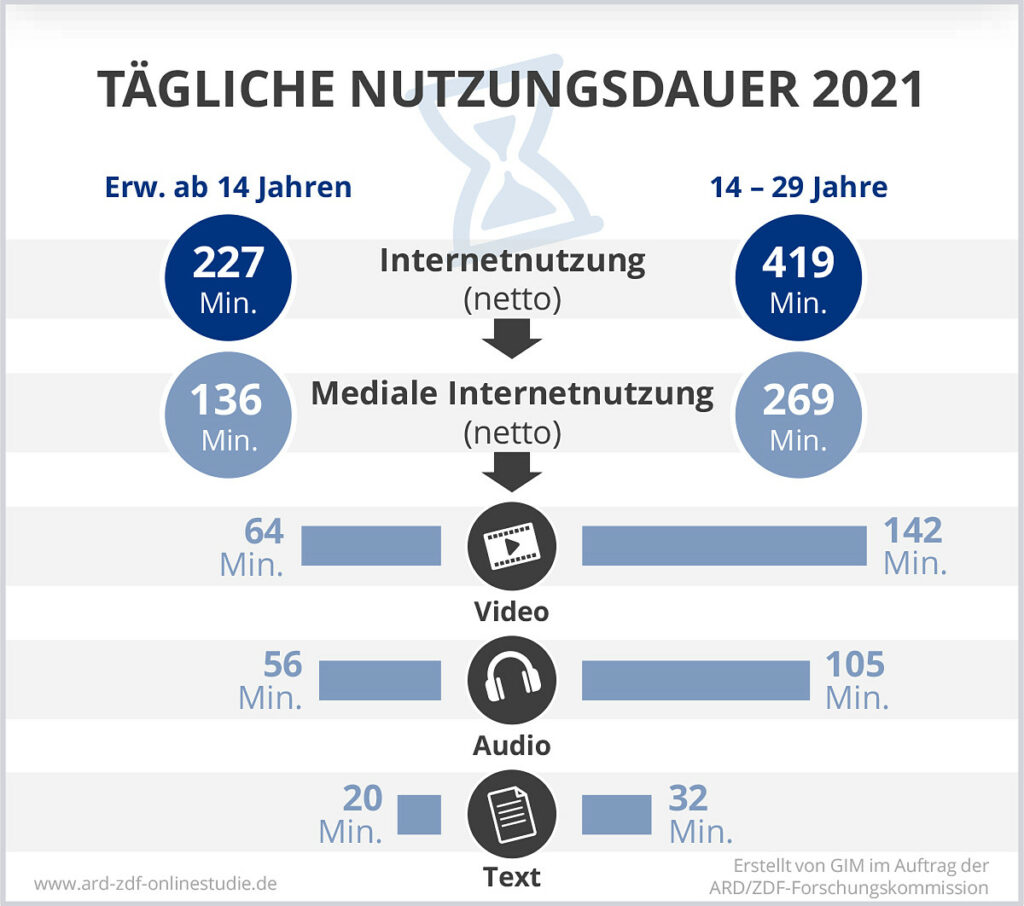
Streaming services and YouTube lead the way
Streaming services such as Netflix and Amazon Prime Video are particularly popular in terms of video content, used daily or weekly by 42 percent, and by as many as 76 percent of 14- to 29-year-olds. The media libraries of the TV stations follow in second place with 38 percent. In the young target group, “other videos on YouTube” are close to the streaming services with 65 percent. Overall, the Google subsidiary is likely to be the most-used platform for video content, at least among the under-30s: The study distinguishes between TV shows on YouTube (21 percent) and those “other videos” (34 percent). In aggregate, YouTube is therefore probably still ahead of Netflix & Co., at least among 14 to 29 year olds, despite a larger assumed intersection.
Among the streaming services themselves, Netflix is the most frequently at least weekly used provider, with 32 percent of all respondents, ahead of Amazon Prime Video (18 percent) and Disney Plus (8 percent). Among the under-30s, Netflix is also the clear top dog with 67 percent, ahead of Amazon (31 percent) and Disney (20 percent).
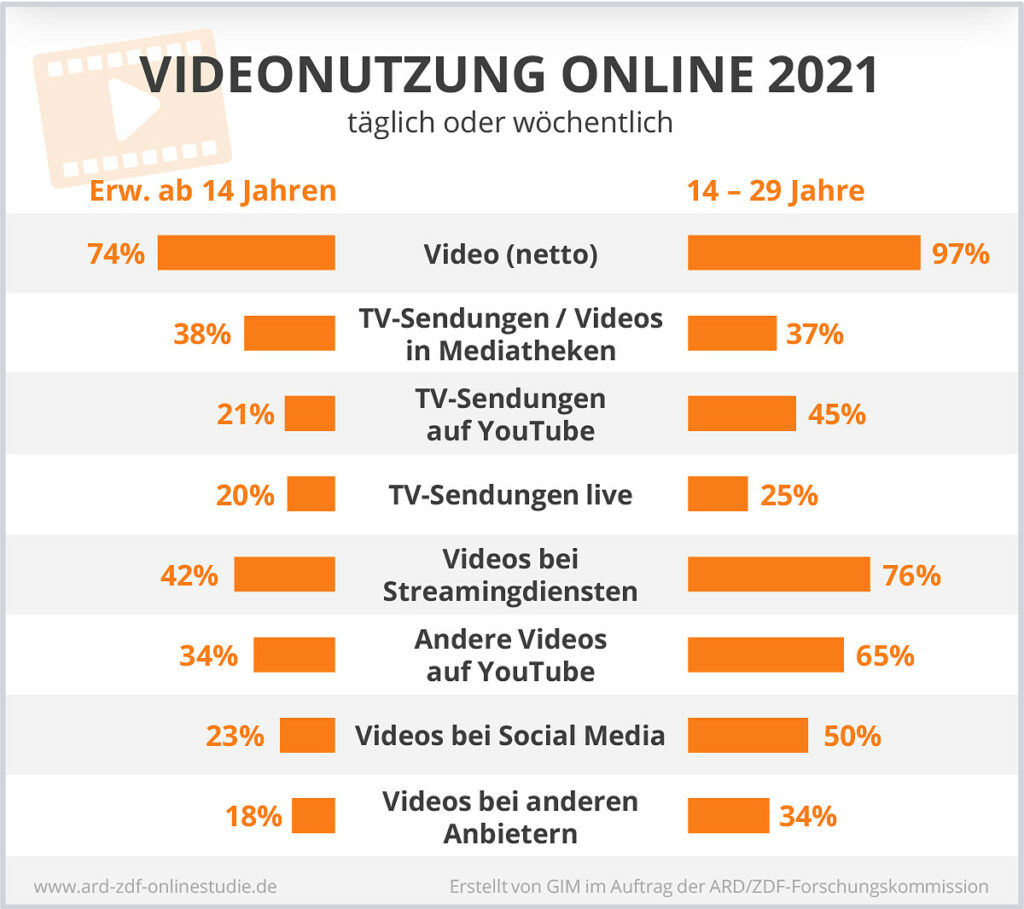
Streaming dominates audio as well
Two-thirds of all respondents listen to audio content on the Internet on a daily or weekly basis, and among 14- to 29-year-olds almost everyone does (98 percent). Music via streaming services or YouTube is particularly popular, but good old radio has also found a popular distribution channel on the Internet. Among the streaming services, Spotify is unsurprisingly the most popular, with 23 percent of respondents using it at least once a week, ahead of Amazon Prime Music with 14 percent. It is striking that Spotify is the only music streaming service to record growth in usage, while its competitors are losing reach. One reason for this is probably that Spotify is increasingly including podcasts and audio books in its portfolio. One in six listens to podcasts at least once a week, in the young target group even one third of all respondents.
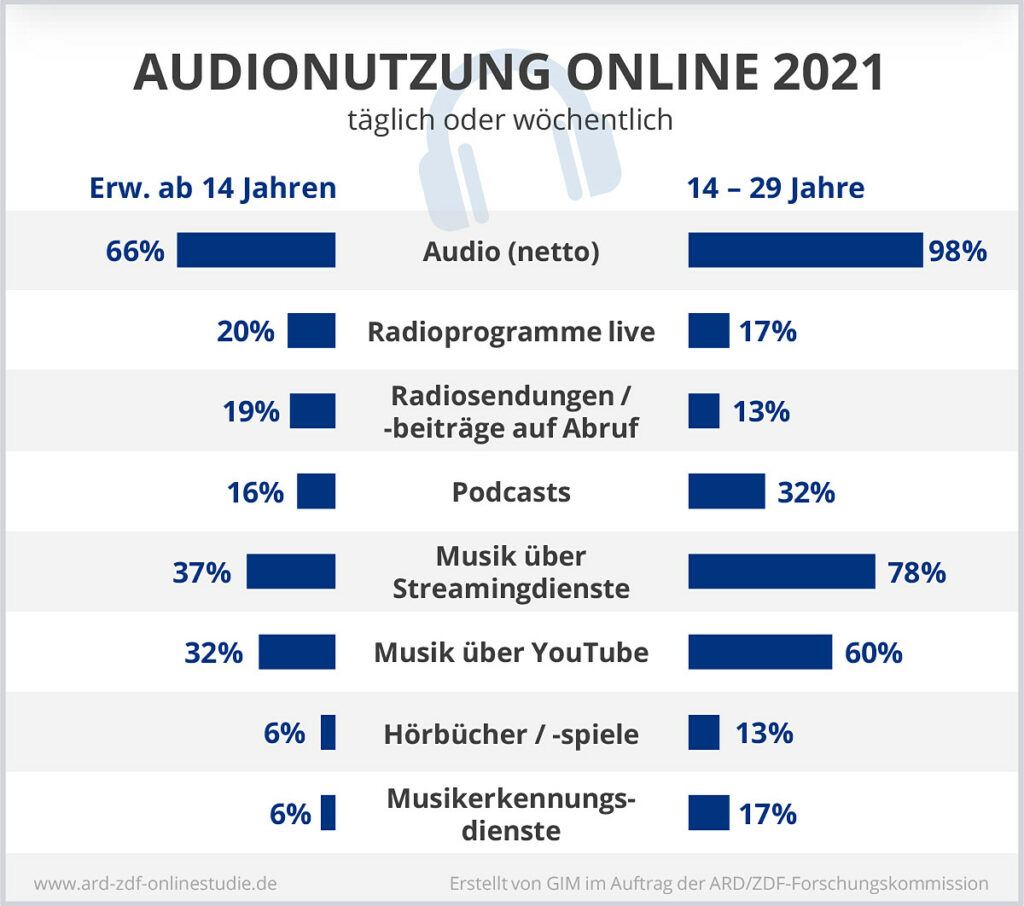
Instagram outpaces Facebook, rising star TikTok
Who is still on Facebook? This truth, which has been felt for years, is slowly finding its counterpart in reality: Although the social media dinosaur is still just about the most used social media application “at least weekly” in 2021 (28 percent of all respondents compared to 26 percent for Instagram), the photo-sharing platform has already overtaken its competitor from Meta Platforms in terms of daily use and comes in at 18 percent, Facebook only at 15 percent.
Among the under-30s, Facebook now only ranks fourth in terms of daily use (17 percent). In this group, TikTok (19 percent) now plays a more important role alongside Instagram (55 percent) and Snapchat (28 percent). The rise of the Chinese network from ByteDance is also documented by the JIM study 2021, which was also recently published and examined the media use of 12- to 19-year-olds for the 24th time: According to the study, 46 percent of this age group use the musical.ly successor daily or several times a week. Only Instagram is more popular with teens, with 58 percent of users using it daily or several times a week. Snapchat follows in third place with 42 percent, Facebook in fourth place with 26 percent.
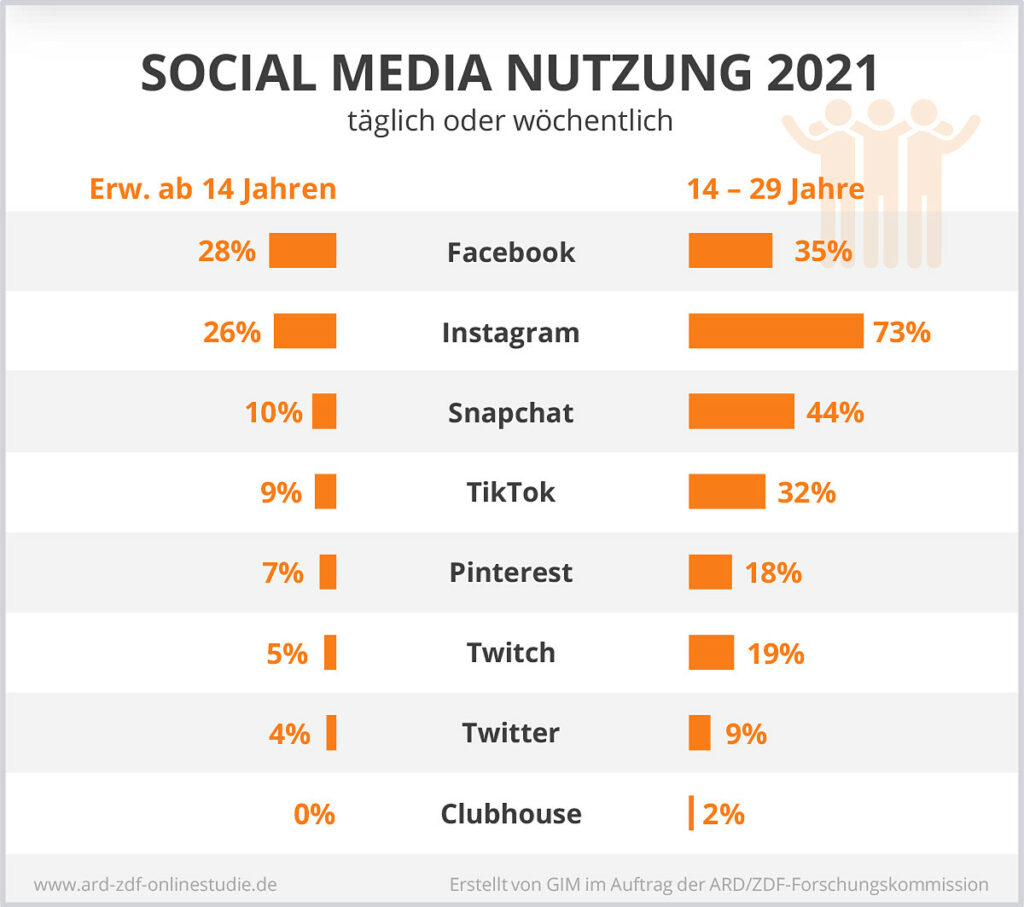
Nothing new with the messengers
Among messengers, WhatsApp is and remains the measure of all things: 70 percent of Germans aged 14 and older use it daily. Telegram, Signal and Threema are a long way behind, with a maximum of 3 percent daily use. Overall, 71 percent of respondents use messenger services on a daily basis, with 93 percent of younger people doing so. According to the JIM study, 92 percent of 12- to 19-year-olds use WhatsApp daily or several times a week. Telegram with 8 percent, Signal with six percent and Threema with four percent are also used more frequently in this age group than in older survey groups.
The ARD/ZDF online study clearly shows the role that the Internet and digital media now play. Two and a half decades after the first study was published, however, it is not only worth taking a look at the current figures. It is precisely in retrospect that the growing importance of a medium whose use in its early days was almost three-quarters dominated by men and which was “a medium for the formally highly educated” becomes clear. A look at the archive is sure to reveal interesting or curious anecdotes from the Internet’s infancy.
*2,001 people in the German-speaking population aged 14 and over in Germany were surveyed.
Cover image: Victoria Heath on Unsplash
A blog post by Daniel Kreuscher
